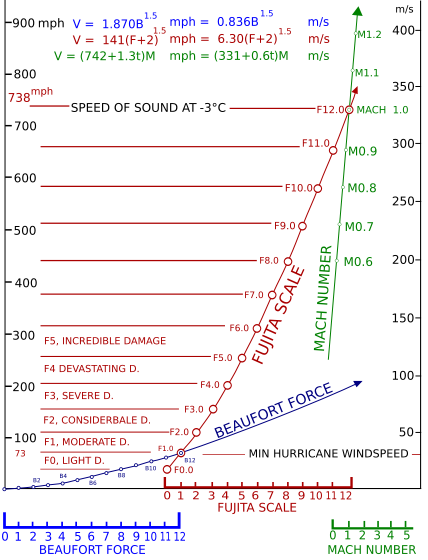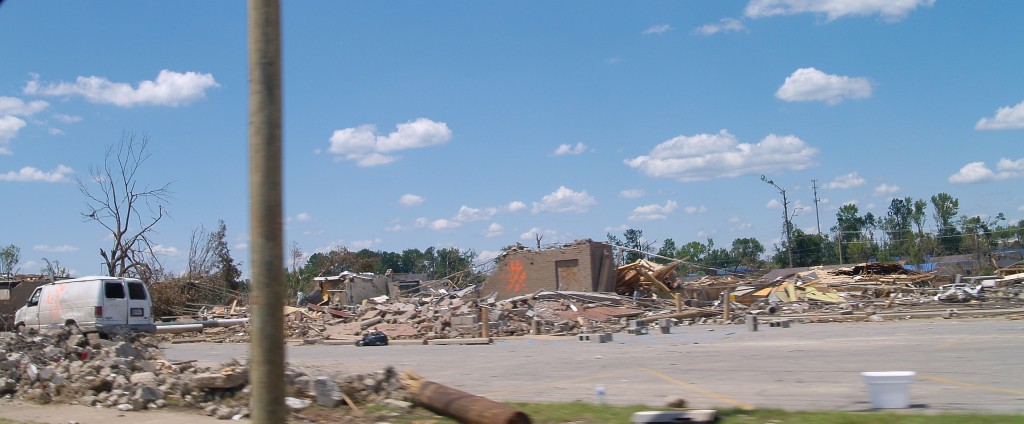Featured image from Kansas City District U.S. Army Corps of Engineers (Flickr CC). Strewn debris from the EF-5 tornado that struck the Joplin, Mo., area, shown June 14, 2011.
By the time I was in second grade, I was a professional at school tornado drills. Our school was an old building with a line of nearly floor to ceiling windows lining the entire length of the classroom. Not exactly the best room to wait out a tornado. When 5 short burst rings sounded, I masterly made my way to the hallway with a textbook. Because of its thickness and robust hard covers, I always chose my math textbook. There crouched down on my knees and elbows, I protected the back of my head and neck with that open textbook. At time I was mastering drills, I was becoming an expert on the F-scale. Indeed, most Southerners know the F-scale as well as they know the words to Sweet Home Alabama. May be better.
The F-scale began with Tetsuya Fujita, a meteorologist from Japan. The town he lived in at the end of World War II was the primary target of one H-Bombs the U.S. dropped. Due to cloudy conditions that bomb was dropped on its secondary target–Nagasaki. Fujita’s study of the damage of the nuclear bomb blasts actually led to a major discovery of meteorological phenomenon called downbursts and microbursts. Perhaps surprisingly given his history, Fujita was recruited to the University of Chicago in 1953. Eventually in 1971, Tetsuya Fujita and Allen Pearson released the F-scale for tornadoes and Fujita himself quickly became known as Mr. Tornado.
 Before 1971, all tornadoes were treated the same no matter their strength, size, path, or damage caused. After, thanks to Fujita and Pearson, scientists could begin to quantify differences in tornadoes, a key step into actually understanding tornadoes. The scale ranges from F1 to F12, linking together the Beaufort scale of wind strength and Mach scale (yes like jets). A F1 tornado corresponds to a 12 on the Beaufort Scale and a F12 corresponds to Mach 1. Tornadoes are rated just from an F0 (40-72 mph) to F5 (261-318) that corresponds to increasing wind speeds. An F5 is enough to wipe a significant portion of that sweet home in Alabama completely off the map. Indeed, on April 27, 2011 two F5 tornadoes cut huge tracks from Tuscaloosa to Birmingham and Rainsville to Sylvania. The tornadoes were strong enough to toss a 35.8-tonne (78,925 lb) coal car 391 feet and partially pull an underground storm shelter out of the ground. An F6? Mr. Tornado himself viewed a F6 tornado as completely unconceivable.
Before 1971, all tornadoes were treated the same no matter their strength, size, path, or damage caused. After, thanks to Fujita and Pearson, scientists could begin to quantify differences in tornadoes, a key step into actually understanding tornadoes. The scale ranges from F1 to F12, linking together the Beaufort scale of wind strength and Mach scale (yes like jets). A F1 tornado corresponds to a 12 on the Beaufort Scale and a F12 corresponds to Mach 1. Tornadoes are rated just from an F0 (40-72 mph) to F5 (261-318) that corresponds to increasing wind speeds. An F5 is enough to wipe a significant portion of that sweet home in Alabama completely off the map. Indeed, on April 27, 2011 two F5 tornadoes cut huge tracks from Tuscaloosa to Birmingham and Rainsville to Sylvania. The tornadoes were strong enough to toss a 35.8-tonne (78,925 lb) coal car 391 feet and partially pull an underground storm shelter out of the ground. An F6? Mr. Tornado himself viewed a F6 tornado as completely unconceivable.

But here’s the kicker in assigning F-scale ratings to tornadoes.
It is practically impossible to measure wind speeds near the ground. Never mind measuring the wind speeds of a tornado over the course of its life from origination to destruction to demise. The F-scale is actually a measure of the damage a tornado causes. Or as referred to by Bill Paxton in one of my favorite movies, “It’s the Fujita scale. It measures a tornado’s intensity by how much it eats.” Assumptions are made that link the damage done, specifically to common wood framed home, to the wind speeds on the F-scale. An F0 cause light damage to chimneys, breaking of trees branches, and damage to sign boards. An F5 causes incredible damage with lifting a framed housed lifted off foundations, carrying it a considerable distances, and the disintegrate it. Cars are tossed through the air over 300 feet. Trees are debarked. Steel reinforced concrete isn’t even safe. The last F5 tornado to occur was in Vilonia, Arkansas in April 27th 2014 just minutes from where I attended college two decades prior.
However as noted by Charles A. Doswell, the meteorologist who contributed to the modern conception of the supercell, the F-scale has issues. “The real-world application of the F-scale has always been in terms of damage, not wind speed. Unfortunately, the relationship between the wind speeds and the damage categories has not been tested in any comprehensive way.” There are several issues that aren’t factored into or estimated in the F-scale.
First, differences in building practices can vary among regions and homes. If your cousin Billy, the strictly for cash under the radar carpenter he is, built the new expansion to your house, chances are the home may not fair very well in even the smallest tornado.
Second, your cousin Billy’s grill, old car, and toilet in his yard, may become tornadic missiles damaging nearby residence. Less junk in the area, less to go airborne, and less damage.
Third, the steadiness and duration of the wind itself can impact damage. If the tornado is a windbag like Billy, those constant winds will cause more damage. Just like Billy.
Fourth, how much wind does it take to make different cars go airborne, damage different types of wood and frames, and different types of architectural styles? Is a 70’s ranch as likely to survive as the new McMansion over the way in Hope Pines? Does Billy’s rusted 73 Ford long bed fly as far as your new Dodge? None of this is quantified.
Engineers also noted that it did not take 300 mile per hour winds (F5) to demolish a house. As Doswell noted, “In order to do this right, we would have to do some sort of controlled experiment in virtually every conceivable tornado situation! This is a practical impossibility.”
All the uncertainty in the F-scale lead to meeting in Grapevine, Texas of the Fujita Scale Enhancement Project which brought together a brain trust of expert meteorologists and civil engineers. Ultimately a more objective scale was created, the Enhanced Fujita Scale, which was unveiled in 2006 at a meeting of the American Meteorological Society. Just a year later it went into operational use in the U.S. The EF-scale has more rigorous and standardized measures of damage, adds additional building and vegetation types, accounts of differences in construction quality, and expands degrees of damage.
But here is the second kicker. While the EF-scale is an improvement, it shares many of flaws of its predecessor. And it comes down to a few simple ideas. Many areas are free from structures and populations. EF0-EF1 ratings predominant in unpopulated areas because of the little damage done to structures. The very famous El Reno, Oklahoma tornado, estimated to have one of the largest diameters ever recorded, could never reach scales of over EF3 because it occurred open country. Moreover, tornado records are plagued with EF unknowns because it requires a detailed assessment. It takes a whole crew in the field after a tornado to assess the damage. Damage for EF-scale is also based on the maximum damage observed in a single spot. But as tornado runs it course, wind speeds can vary greatly. Indeed, the highest damage levels of EF4-5 tornadoes occupy less than 10% of the track.
Clearly there is a need for a better scale for tornado size. Doswell points to a committee of the American Society of Civil Engineers, a sort of Supreme Court for tornado strength assignments. Ratings of tornadoes would be submitted to a committee who would evaluate the proposed rating and ensure standards were met. This committee is developing a standards committee to evaluate all possible ways to measure wind speed though radar, direct measurements, course damage, and even tree falls. “A study done at turn at the 20th century found if you knew speed and pattern of winds, then directions of tree falls could be use to estimate speed.”
